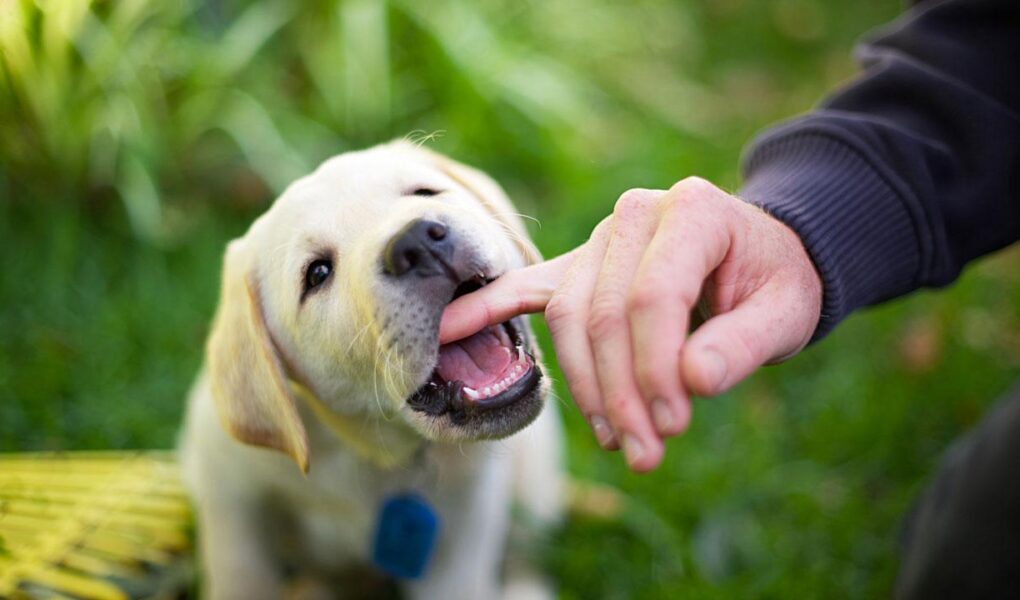Title: Understanding Your Energetic Friend: Why Your Puppy Won’t Stop Biting
Introduction:
Welcoming a puppy into your home is like introducing a whirlwind of joy and excitement. Their tiny paws, floppy ears, and enthusiastic wagging tails can transform any mundane day into a playful adventure. However, amidst the cuteness and cuddles lies a challenge that many new pet owners face: the incessant biting. Whether it’s tugging at your shoelaces, nipping at your fingers, or playfully wrestling with a couch cushion, that irresistible urge to bite can leave you feeling overwhelmed and perplexed. In this article, we’ll explore the reasons behind this common behavior and provide practical tips to guide your furry friend toward a more gentle approach to play. Understanding this phase in your puppy’s development will not only help you manage their behavior more effectively but also strengthen the bond between you and your spirited companion. So, let’s dive into the world of puppy nibbles and learn how to transform those playful bites into a more positive interaction.
Table of Contents
- Understanding the Reasons Behind Puppy Biting Behavior
- Effective Approaches to Redirecting Biting Habits
- Creating a Positive Training Environment
- Building Trust Through Gentle Interaction Techniques
- Q&A
- Final Thoughts
Understanding the Reasons Behind Puppy Biting Behavior
Puppies often engage in biting behavior as a natural part of their development, driven by several underlying reasons. Firstly, they explore their world through their mouths, much like how human infants do. This exploration can manifest as nipping or biting at fingers, clothes, or furniture. Additionally, teething can cause discomfort, prompting puppies to chew and bite to relieve the pressure on their gums. It’s essential to understand that this behavior is typically not aggressive but rather a form of communication and play. As they grow, puppies need to learn what is acceptable to bite and what isn’t, forming the foundation for their social skills.
Another significant factor influencing biting behavior is a puppy’s energy levels and need for stimulation. Boredom or excess energy can lead to undesirable behaviors, including biting. Dogs are highly social creatures that thrive on interaction and activity. If they are not adequately engaged with toys, exercises, or human companionship, they may resort to mouthing or nipping to get attention. To curb this behavior, consider implementing the following strategies:
- Provide Chew Toys: Offer a variety of toys to divert their biting urge.
- Interactive Play: Regular playtime helps burn off excess energy.
- Positive Reinforcement: Reward good behavior to reinforce limits on biting.
Effective Approaches to Redirecting Biting Habits
Redirecting a puppy’s biting habits requires patience and consistency. One of the most effective methods is to provide appropriate chew toys that can satisfy their natural urge to chew. By offering various textures and sizes, you can keep your puppy engaged while steering them away from inappropriate biting. Consider these alternatives:
- Rubber toys: Durable and great for teething.
- Rawhide chews: A classic option, but monitor for safety.
- Interactive toys: Encourage play and distract from biting.
Moreover, incorporating positive reinforcement can greatly enhance your puppy’s learning experience. Whenever your puppy engages in gentle play or chooses their toy over your hands, be sure to praise and reward them. This positive feedback helps create a connection between good behavior and rewards. You can implement a simple reward system:
| Behavior | Response |
|---|---|
| Choosing a toy | Verbal praise and a treat |
| Gentle play | Playtime extension or extra affection |
| Ignoring human hands | Immediate reward with a favorite toy |
Creating a Positive Training Environment
Establishing an inviting atmosphere is crucial when tackling the challenge of a puppy that won’t stop biting. A nurturing environment fosters trust, making your puppy feel safe and secure. Here are some elements to consider for creating a positive experience:
- Consistent Routine: Set a daily schedule for playtime, feeding, and training sessions.
- Safe Space: Designate a comfortable area with toys where your puppy can explore without fear.
- Positive Reinforcement: Use treats or praises to reward good behavior, reinforcing what is desirable.
- Calm Energy: Keep your tone soothing and your movements gentle to avoid overwhelming your puppy.
Additionally, understanding your puppy’s needs can significantly reduce biting incidents. Consider keeping a characteristics table to track specific behavior patterns and triggers. This can help you identify what excites or agitates your puppy, allowing you to make informed adjustments to your training approach.
| Trigger | Reaction | Action to Take |
|---|---|---|
| Excited Play | Biting hands and clothes | Redirect to toys |
| Stranger Interaction | Nipping at legs | Introduce calmly and reward |
| Overstimulation | Hyperactivity | Take a break, use a calm tone |
Building Trust Through Gentle Interaction Techniques
Interactions with your puppy can significantly shape their behavior, and incorporating gentle techniques can foster a trusting relationship that discourages biting. Start by using positive reinforcement to encourage desired behaviors. Here are some effective methods to implement:
- Redirecting: When your puppy begins to bite, gently redirect their energy to a chew toy.
- Praise and Treats: Offer praise and treats when they play softly or use their toys instead of your hands.
- Calm Disengagement: If your puppy starts biting, calmly stop interacting and walk away for a brief moment.
It’s vital to understand the reasons behind the biting, as puppies often do this to explore and play. Creating a structured environment where they can safely interact is key. Here’s a quick look at what you can do:
| Technique | Description |
|---|---|
| Socialization | Expose your puppy to various social settings and different dogs. |
| Training Sessions | Incorporate short, engaging training sessions that teach commands. |
| Consistent Routine | Establish a daily routine that includes playtime and quiet time. |
Q&A
Q&A: Understanding Why Your Puppy Won’t Stop Biting
Q1: Why is my puppy biting so much?
A: Puppies explore their world through their mouths, much like human infants. Biting is a natural behavior for them, often related to teething, playfulness, or simply seeking attention. It’s crucial to remember that what seems like a playful nibble can quickly escalate if not addressed.
Q2: Is biting a sign of aggression?
A: Not necessarily. Puppies often bite out of excitement, curiosity, or the instinct to play. However, if the biting is accompanied by growling, snarling, or a stiff posture, it may indicate fear or aggression. Monitoring your puppy’s body language will help you determine the intention behind the bites.
Q3: What can I do to discourage biting?
A: Start by redirecting your puppy’s biting to appropriate toys or chews. When they bite you, let out a high-pitched yelp to mimic what a littermate would do, signaling that the behavior is not acceptable. Consistency is key—make sure everyone in your household uses the same methods to discourage biting.
Q4: How do I differentiate between playful biting and aggressive biting?
A: Playful biting is typically gentle, accompanied by a wagging tail, and repeated attempts to engage with you. Aggressive biting often includes tense body language, low growls, or biting that breaks the skin. If you’re unsure, consult a professional trainer to evaluate your puppy’s behavior.
Q5: Will my puppy outgrow this biting phase?
A: Most puppies will reduce their biting as they mature and learn more appropriate behaviors. However, if left unchecked, biting can become a persistent issue. Early intervention with training and positive reinforcement can help pave the way to a more respectful companion.
Q6: Are certain breeds more prone to biting?
A: While some breeds may have higher energy levels or assertive natures, all puppies can exhibit biting behaviors. It largely depends on their upbringing, socialization, and training rather than breed alone. Focus on socializing your puppy with different people and environments to help minimize biting tendencies.
Q7: When should I seek professional help?
A: If your puppy’s biting becomes excessive, is causing injury, or if you’re feeling overwhelmed, it’s wise to reach out to a professional dog trainer or behaviorist. Early intervention can provide tools and techniques tailored to your puppy’s specific needs.
Q8: What role does socialization play in stopping biting?
A: Socialization is a crucial aspect of your puppy’s development. Introducing them to new experiences, people, and dogs can help them learn appropriate play behavior and reduce the likelihood of biting. Classes that emphasize positive interactions with other dogs can be particularly beneficial.
Q9: Are there specific toys that can help with biting?
A: Yes! Toys that are durable and designed for teething can help satisfy your puppy’s urge to bite. Look for rubber toys, dental chews, or ropes designed for tugging. Providing a variety of toys can keep your puppy engaged and prevent them from targeting your hands or furniture.
Q10: How can I improve my relationship with my puppy despite their biting?
A: Patience and consistent positive reinforcement are key. Engage in regular playtime and training sessions to strengthen your bond. Celebrate small victories and remember that building a trusting relationship takes time, especially when navigating developmental behaviors like biting.
Final Thoughts
navigating the playful yet sharp antics of a teething puppy can be a multifaceted journey filled with both challenges and rewards. By understanding the underlying reasons behind your puppy’s biting behavior and employing the strategies discussed, you can transform those tiny, gnashing teeth into a more gentle and playful approach to interaction. Remember, patience and consistency are your greatest allies in this training adventure. With time, your puppy will learn the boundaries of appropriate play, and you will pave the way for a lifetime of joyful companionship. So, take a deep breath, grab that chew toy, and embark on this journey together—because the bond you’re building now will last a lifetime.



